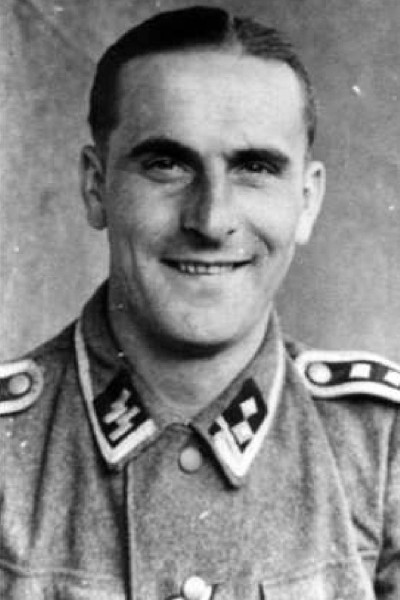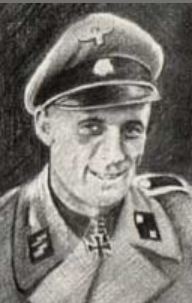Rech, Erich (SS-Pz-AA 10)
- Date of birth:
- December 15th, 1921 (Groß-Latzkow, Pyritz, Pomerania, Germany)
- Date of death:
- October 4th, 1944 (Bemmel, the Netherlands)
- Buried on:
- German War Cemetery Ysselsteyn
Grave: onbekend. - Service number:
- SS-Nr.: // NSDAP-Nr.:
- Nationality:
- German
Biography
Erich Rech reached the rank of SS-Untersturmführer. He was killed in the fightings at Bemmel on October 4th, 1944. He was buried as an unknown soldier at the German Cemetery Ysselsteyn.
1933: Hitlerjugend
01.11.1939: joined the Waffen SS - SS-Ersatz-Bataillon 'Germania' - Hamburg-Langenhorn
13.11.1939-01.05.1940: Lehr Kompanie - 1./ SS-Ersatz- Bataillon 'Germania' - SS-Junkerschule Bad Tölz
28.08.1940: appointed to the 15./ SS-Regiment 'Westland'
06.1941: campaign in Russia
01.07.1941: promoted to SS-Sturmmann
01.08.1941: promoted to SS-Rottenführer
26.09.1942: WIA in Terek
11.1942: transferred to the Kradschützen-Esratz-Bataillon in Ellwangen
21.03.1943: promoted to SS-Unterscharführer
25.03.1943: transferred to the Panzer Aufklärungs-Abteilung 10, 10. SS-Panzer Grenadier Division 'Frundsberg' as patrol leader in the 2./ SS-Pz-AA 10
17.08.1944: promoted to SS-Untersturmführer for bravery
04.10.1944: MIA Bemmel, south of Nimwegen
23.10.1944: his body was found and he was declared KIA
Do you have more information about this person? Inform us!
- Period:
- Second World War (1939-1945)
- Rank:
- SS-Sturmman (Private 1st Class)
- Unit:
- MG-Schütze 1, 15. Kompanie, SS-Regiment 'Westland', SS-Division 'Wiking'
- Awarded on:
- July 13th, 1941
- Period:
- Second World War (1939-1945)
- Rank:
- SS- Rottenführer (Corporal)
- Unit:
- 15. Kompanie, SS-Regiment 'Westland', SS-Division 'Wiking'
- Awarded on:
- April 20th, 1942
- Period:
- Second World War (1939-1945)
- Rank:
- SS- Rottenführer (Corporal)
- Unit:
- 15. Kompanie, SS-Regiment 'Westland', SS-Division 'Wiking'
- Awarded on:
- November 5th, 1942
- Period:
- Second World War (1939-1945)
- Period:
- Second World War (1939-1945)
- Rank:
- SS-Unterscharführer (Sergeant)
- Unit:
- IV. Zug, 2. Schwadron, SS-Aufklärungs-Abteilung10, 10. SS-Panzergrenadier-Division 'Frundsberg'
- Awarded on:
- June 12th, 1944
- Period:
- Second World War (1939-1945)
- Rank:
- SS-Oberscharführer (Staff Sergeant)
- Unit:
- Zugführer, 2. Kompanie, SS-Panzer-Aufklärungs-Abteilung 10, 10. SS Panzer-Division "Frundsberg", Waffen-SS
- Awarded on:
- August 23rd, 1944
“The commander of the SS-Pz.Aufkl.Abt. 10 requests that the Knight’s Cross of the Iron Cross be awarded to SS-Oberscharführer Erich Rech, Zug and Spähtruppführer in the 2.(Pz.Sp.-) Kompanie of the SS-Panzer-Aufklärungs-Abteilung 10.
Justification:
On the 03.08.1944 the SS-Pz.Aufkl.Abt. 10 had the mission to reconnoiter the frontline south of Caumont along the line Culvain—Jurques with reinforced recon units. Their goal was to determine the extent of the enemy penetration in this area.
Due to the strong enemy pressure the frontline was pulled back to the line St. Georges—La Bigne—Hill 302—Hill 321. A further withdrawal was scheduled on the night of the 03.-04.08.1944. As the new main line was not yet fully ready for defense, an intermediate position was set up along the line Ondefontaine church—Point 297—Point 259.
SS-Oberscharführer Rech had the mission of securing the crossroads at Point 297 with a reinforced recon unit, reporting on the units that were falling back and personally withdrawing with the last elements.
After the last man had passed through the intermediate position, SS-Oberscharführer Rech decided to go forward about 3 km forward through the Bois du Min Ronceuz forest with one man from his unit, as he wanted to determine how far the enemy’s attacking spearheads had gotten. After he encountered enemy security units, he pulled back. Having been shot at several times along the retreat path, he ascertained the presence of enemy infantry in the forest to the right and the left. When Rech came back to his recon unit the intermediate position was no longer occupied. Friendly contact to the right and left had been cut, and enemy infantry and tanks were already in his rear.
Rech thus began moving south along the road with his reconnaissance unit. Here he met soldiers from the Division-Begleit-Kompanie, who reported to him that some wounded men near Point 297 had been left behind due to the strong enemy pressure. Rech thus drove forward in his combat vehicle, fighting off enemy infantry and fetching the wounded men from certain capture.
In the meantime enemy tanks and infantry had approached from the south to a point so close to the reconnaissance unit that a breakthrough with SPWs seemed hopeless. But SS-Oberscharführer Rech did not wish to abandon the vehicles, and decided to break through along the road despite the enemy tanks. Taking advantage of a surprise barrage by friendly rocket artillery, Rech burst out of the forest with his recon patrol, all guns blazing. The unit punched its way through the lines of the surprised enemy and succeeded in making it through without losses. As the forward vehicle, Rech wished to immediately find the command post ‘Bünning’ in order to report on the situation. However on the way there he learned from retreating infantry that the Chateau in which the command post was located was already in enemy hands. Rech thus drove on further and met with the adjutant of the Kampfgruppe ‘Bünning’ about 800 metres east of the Chateau. He asked Rech to bring up reinforcements as soon as possible, as the men of the security line had left their posts and were fleeing in disorder. Consequently Rech drove back, rounded up all the retreating elements and brought them back to the security line.
The energetic intervention of SS-Oberscharführer Rech meant that the security line could be restored and the enemy held here. Without his intervention, his active and determined actions, as well as his precise and accurate reports, the enemy would have been able to seize the new main line before it was fully ready for defense. The orderly nature of the withdrawal would have been doubtful without his intervention. He remained in contact with the enemy, and only after the new defensive line was ready did he proceed to the divisional command post to report on the current situation.
The repeated appearances of Rech at different positions, whereby he fought the enemy while inflicting high losses, meant that the advance of the enemy was significantly delayed despite their strong superiority. Through Rech’s personal bravery, several wounded were also salvaged. It is also heavily to his credit that the new main line could be occupied without disruption by the enemy. Despite his constant activities Rech was nevertheless able to repeatedly pass on clear and accurate messages to the Division, which enabled it to take the necessary measures with a true understanding of what was going on.
Having shown great bravery and prudence during this time, SS-Oberscharführer Rech is worthy of being awarded the Knight’s Cross to the Iron Cross.”
Sources
- Photo 1: Igor Poul
- Photo: Erich Rech (1921-1944) - Find a Grave-gedenkplek
- Details ǀ Berliner Auktionshaus - - FELLGIEBEL, W.P., Elite of theThird Reich, Helion & Company Limited, Solihull, 2003.
- Volksbund
- Microfilm Publication A3343. US National Archives.









